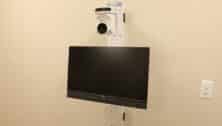Make 2025 the Year to Upgrade Your Hybrid Meeting System

While business forecasters are calling for an increased emphasis on employees returning to their physical offices, the explosion of remote employees and the need to connect across geography and time zones still makes hybrid meetings a business necessity.
With that in mind, few things disrupt a hybrid meeting more than dated technology, said A.J. Antonio, an Integration Account Manager with Haverford Systems in Downingtown.
“An effective hybrid meeting system should be both seamlessly integrated into the space in which the meeting is taking place and give the feeling that the meeting participants are in the same room,” he said. “Making sure your technology is keeping up with new developments is important to running effective meetings.”

If you’ve decided 2025 is the year for your business to upgrade its hybrid meeting setup, Antonio suggested some changes to consider.
Expand Your Platforms
First is a multi-platform conferencing system from a provider like Cisco, Antonio said. “For some conferencing systems, you have to choose a single platform — such as Zoom, Microsoft Teams, or Google Meet — to run on. This is a challenge for organizations that switch between conferencing platforms.”
The Cisco system, for example, works across Cisco’s proprietary Webex platform, in addition to Zoom, Teams, and Meet, allowing everyone on your team to collaborate seamlessly via video conferencing.
“Though multi-platform systems are a bit more expensive than single-platform systems, the convenience and increased productivity can far outweigh the cost,” Antonio said.
Take a New Look at Cameras
Another potential upgrade is to add more cameras to your conferencing system. This might include a video bar, a fixed camera with a panoramic lens to take in an entire room; a pan/tilt/zoom (PTZ) camera to track specific individuals or groups; or a camera specially designed to livestream a whiteboard while a meeting is in progress.
“The goal with adding cameras is to provide the most possible coverage of who’s in your conference room, so those participating remotely feel more engaged and present,” Antonio said.
A complement to expanded camera coverage is speaker tracking technology that integrates a meeting room microphone with a PTZ camera and uses artificial intelligence to individually focus on a speaker based on their position in the room.
Go Ultra-Widescreen
For those in the meeting room, it’s often challenging to view everyone participating remotely because of screen size limitations.
“Companies like LG are helping to solve this problem with new monitors built in an ultrawide 21:9 aspect ratio, compared to most which are 16:9,” Antonio said. “This wider format provides more room for remote participant windows, making for a more comfortable viewing experience in the meeting room.”
The new displays also benefit from enhanced layout options in Microsoft Teams Front Row and Zoom, he said.
Make Better Connections
Finally, there’s the addition of improved connectivity. As USB-C has become the standard for many laptops, the ability to easily connect has been in huge demand.
“We’re excited to see some new releases that will allow you to connect to a dual-display monitor with a USB-C cable, which is a universal and efficient solution that improves efficiency and reduces clutter,” Antonio said. “The adoption of the USB-C connection not just makes for a quicker and more reliable data transfer, but also streamlines the installation process.”
Your Hybrid Meeting Specialists
Haverford Systems has a team of locally based experts dedicated to improving your hybrid meeting experience. Whether it’s upgrading your cameras, installing voice tracking systems, or helping you decide on a new display, Haverford Systems can build or upgrade your system in a way that meets your needs and maximizes your budget.
Connect With Your Community
Subscribe to stay informed!
"*" indicates required fields










![95000-1023_ACJ_BannerAd[1]](https://vista.today/wp-content/uploads/2023/03/95000-1023_ACJ_BannerAd1.jpg)










































